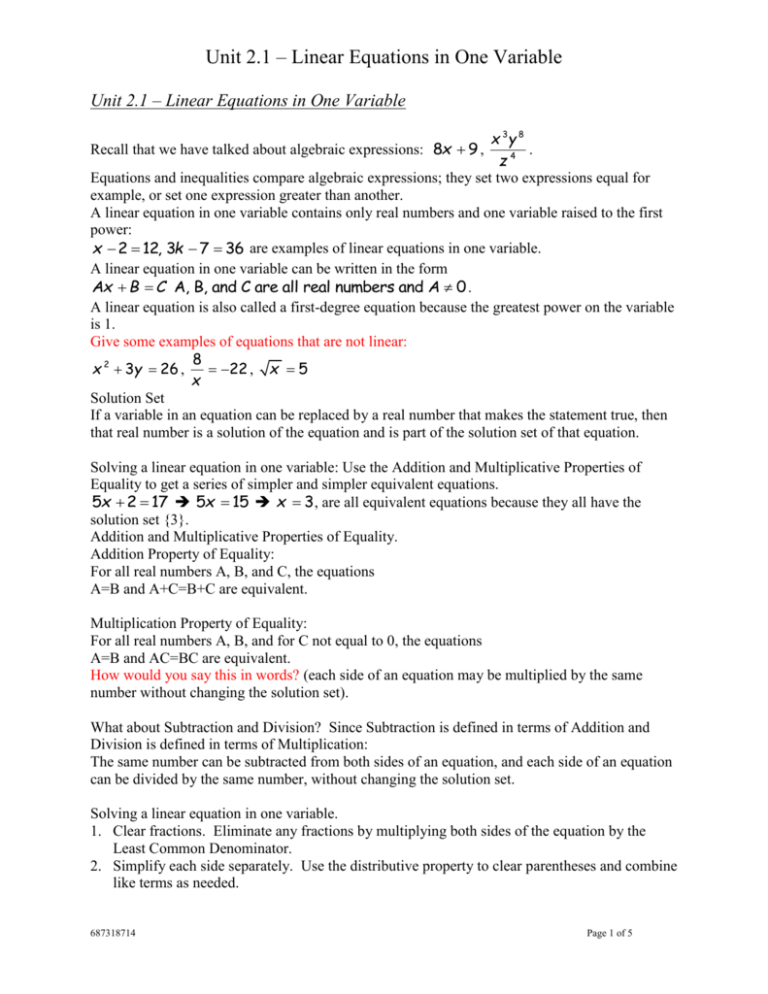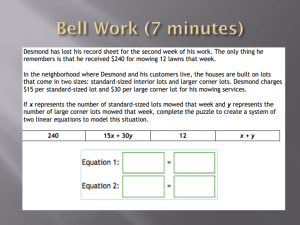Unit 2 - Linear Equations and Applications
advertisement

Unit 2.1 – Linear Equations in One Variable
Unit 2.1 – Linear Equations in One Variable
x 3y 8
.
z4
Equations and inequalities compare algebraic expressions; they set two expressions equal for
example, or set one expression greater than another.
A linear equation in one variable contains only real numbers and one variable raised to the first
power:
x 2 12, 3k 7 36 are examples of linear equations in one variable.
A linear equation in one variable can be written in the form
Ax B C A, B, and C are all real numbers and A 0 .
A linear equation is also called a first-degree equation because the greatest power on the variable
is 1.
Give some examples of equations that are not linear:
8
x 2 3y 26 ,
22 , x 5
x
Solution Set
If a variable in an equation can be replaced by a real number that makes the statement true, then
that real number is a solution of the equation and is part of the solution set of that equation.
Recall that we have talked about algebraic expressions: 8x 9 ,
Solving a linear equation in one variable: Use the Addition and Multiplicative Properties of
Equality to get a series of simpler and simpler equivalent equations.
5x 2 17 5x 15 x 3 , are all equivalent equations because they all have the
solution set {3}.
Addition and Multiplicative Properties of Equality.
Addition Property of Equality:
For all real numbers A, B, and C, the equations
A=B and A+C=B+C are equivalent.
Multiplication Property of Equality:
For all real numbers A, B, and for C not equal to 0, the equations
A=B and AC=BC are equivalent.
How would you say this in words? (each side of an equation may be multiplied by the same
number without changing the solution set).
What about Subtraction and Division? Since Subtraction is defined in terms of Addition and
Division is defined in terms of Multiplication:
The same number can be subtracted from both sides of an equation, and each side of an equation
can be divided by the same number, without changing the solution set.
Solving a linear equation in one variable.
1. Clear fractions. Eliminate any fractions by multiplying both sides of the equation by the
Least Common Denominator.
2. Simplify each side separately. Use the distributive property to clear parentheses and combine
like terms as needed.
687318714
Page 1 of 5
Unit 2.1 – Linear Equations in One Variable
3. Isolate the variable terms on one side. Use the addition property to get all terms with
variables on one side of the equation and all numbers on the other.
4. Isolate the variable. Use the multiplication property to get an equation with just the variable
(with a coefficient of ‘1’) on one side.
5. Check. Substitute the proposed solution into the original equation.
Recognizing Conditional Equations, Identities, and Contradictions.
Type of Linear
Number of Solutions
Indication when solving
Equation
Conditional
One
Final line is x = a number.
Contradiction
None; solution set ø
Final line is false, i.e.
-15 = -20
Identity
Infinite; solution set {all real Final line is true, i.e.
numbers}
5=5
5x 2 2x 1 3x 1
contradiction; null set
x 1 2x
1
x identity; {all real numbers}
3
3
3
53x 1 x 5
conditional; {0}
Unit 2.2 – Formulas
A mathematical model is an equation or inequality that describes a real situation.
A formula is a mathematical model in which variables are used to describe a relationship.
d rt , I prt , C 2 r
It is often useful to solve a formula for a variable other than the obvious one. For example, solve
for ‘r’ in the circumference formula or solve for ‘t’ in the interest formula.
The process is exactly the same as solving a linear equation in one variable. You use all the
same steps.
The key is to treat the variable you are solving for as if it were the only variable in the formula.
Treat all the other variables as if they were numbers. (Typically we refer to variables being
treated as numbers as ‘constants’.)
400 W L
solve for L K 917 6 w h a solve for h
N
25 r a b
solve for b.
V
r b
R r
Remember that percent means ‘per one hundred’. And to calculate a percentage we take the
amount and divide it by the base or total.
687318714
Page 2 of 5
Unit 2.1 – Linear Equations in One Variable
How would we determine the percentage of girls in this class?
Number of girls divided by total number of students.
Unit 2.3 and Unit 2.4 – Applications of Linear Equations
Be sure you understand how to translate from words to mathematical expressions.
Verbal expression
Mathematical expression (x and y are numbers)
Addition
The sum of a number and 7
x+7
6 more than a number
x+6
3 plus a number
3+x
24 added to a number
x + 24
A number increased by 5
x+5
The sum of two numbers
x+y
Subtraction
2 less than a number
x–2
12 minus a number
12 – x
A number decreased by 12
x – 12
A number subtracted from 10
10 – x
The difference between two numbers
x–y
Multiplication
16 times a number
16x
A number multiplied by 6
6x
2
2
of a number (used with fractions and
x
3
3
percents)
Twice a number
2x
The product of two numbers
xy
Division
The quotient of 8 and a number
8
x≠0
x
A number divided by 13
x
13
The ratio of two numbers or the quotient of
x
x≠0
two numbers
y
Be careful to distinguish between expressions and equations.
Solving an Applied Problem
1. Read the problem until you understand what is given and what you are looking for.
2. Assign a variable to represent the unknown variable. Use diagrams or tables if it helps.
Express other unknown values in terms of the variable.
3. Write an equation using the variable expressions.
687318714
Page 3 of 5
Unit 2.1 – Linear Equations in One Variable
4. Solve the equation.
5. State the answer to the problem. Ask yourself: does this seem reasonable?
6. Check your answer in the original problem.
Examples:
1) Finding Unknown Quantities
At the end of the 2003 baseball season, Sammy Sosa and Barry Bonds had a lifetime total of
1197 home runs. Bonds had 119 more than Sosa. How many home runs did each player have?
The equation to solve is Sosa + Bonds = Total
Set x = Sosa home runs. Therefore, Bonds home runs = x + 119.
Equation to solve is x + (x + 119) = 1197.
2) Percentage Problem
Michele Raymond was paid $162 for a week’s work after 10% deductions for taxes. How much
did she make before the deductions were made?
The equation to solve is Net Pay = Total pay – Deductions.
Also consider that Deductions = Deduction % times Total Pay.
Rewrite the equation as Net Pay = Total pay – (Deduction % x Total Pay).
Substitute and solve 162 = y – (10% x y) or 162 = y – .1y.
3) Investment Problem
A woman invests $72,000 in two ways – some at 5% and some at 3%. Her total annual interest
income is $3,160. Find the amount she invests at each rate.
The formula for simple interest is I = prt (where I = interest, p = the amount invested or the
principal, r = the interest rate, and t = time invested). In this problem, the time is 1 year so t = 1
so we can ignore it.
Assign a variable:
Let x = the amount to invest at 5%. So 72000 – x = the amount to invest at 3%.
The equation to solve is Interest @ 5% + Interest @ 3% = Total Interest.
Substitute and solve: .05x + .03(72000 – x) = 3160.
4) Mixture Problem
How many liters of a 10% solution should be mixed with 60 liters of a 25% solution to get a 15%
solution?
You are looking for x = the number of liters of 10% solution.
You have 60 liters of 25% solution and will mix x liters of 10 % solution therefore you will end
up with (60 + x) liters of 15% solution.
Write an equation: .25(60) + .1x = .15(60 + x) and solve for x.
5) Money Denomination Problem
A cashier has 26 coins consisting of dimes and half-dollars. The total value of these coins is
$8.60. How many of each type does he have?
Assign variables: x = number of dimes, therefore (26 – x) = number of half-dollars.
Each dime is worth $0.10 and each half-dollar is worth $0.50 so the equation looks like this:
.1x + .5(26 – x) = $8.60.
687318714
Page 4 of 5
Unit 2.1 – Linear Equations in One Variable
Motion Problems – for motion problems you use the basic formula d rt . Key to solving many
motion problems is to determine what is the same. (For example: if the distance is the same, you
would set the rate x time of one vehicle to the rate x time of the second. You have set the
distances equal and can solve the problem.)
6) Motion Problem (Motion in Opposite Directions)
Two cars leave the same location at the same time. One travels north at 60 mph and the other
travels south at 45 mph. In how many hours will they be 420 miles apart?
In this problem you have two distances that will add up to 420 miles. In order to solve, express
the distance each car travels as rate x time. Then add the two distances together to equal 420
miles.
The equation to solve is: 45x 60x 420
7) Motion Problem (Motion in the Same Direction)
Elayn begins jogging at 5:00am, averaging 3mph. Clay leaves at 5:30am, following her,
averaging 5mph. How long will it take for him to catch up with her?
Both joggers are traveling in the same direction and Clay is going faster so he will eventually
catch up to her. It is important to realize that they will have traveled the same distance when
Clay catches up to Elayn. So we will set the distances equal to each other. We will express the
distance as the rate x time of each runner.
1
The equation to solve is 5 x 3 x . Clay runs for x hours so his distance is 5mph for x
2
1
hours. Elayn runs for x hours (remember she leaves half an hour before Clay), so her
2
1
distance is 3mph for x hours.
2
687318714
Page 5 of 5








